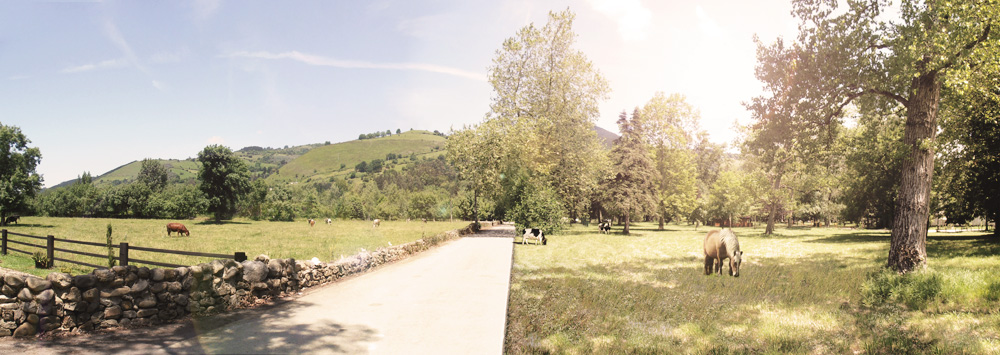land-use planning, management plan and landscape project for espacio Toranzo livestock research centre
location: Valle de Toranzo, Cantabria, Spain
year: 2013
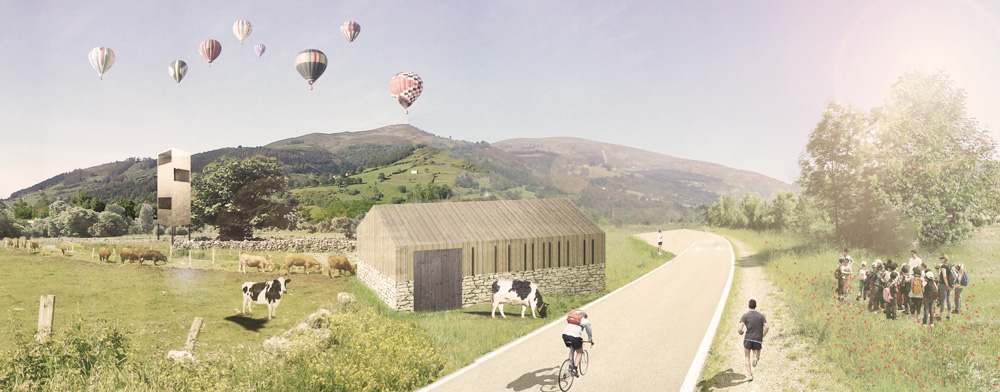
Questions about identity, character and use of land always raise while studying the periurban areas we usually find on the city limits. In rural areas, these questions are also inquired when villages and towns are planned to grow as second home areas despite their close ties with the territory, the agriculture and livestock production, the mining and the forestry, and definitely with the human transformed land in which they are found. These rural areas are commonly used to locate new economic activities because of the low cost of the plots and a lack of regulations: it is widely accepted that the aim is to fix the local population by offering new opportunities and jobs based on other different economies, such as trading, tourism or industry. But we could also argue that these new neighbourhoods share the same defects and the lack of identity of the big cities’ periurban areas, even if the dynamics of the rural economy -involving agriculture, fishing, livestock production or forestry- are stronger in these areas thereafter. Therefore, the substitution of the rural dynamics transforms the landscape while the new housing areas acquire an identity which becomes sub-rural and not only rural. Somehow, they are defining a completely different and new landscape.
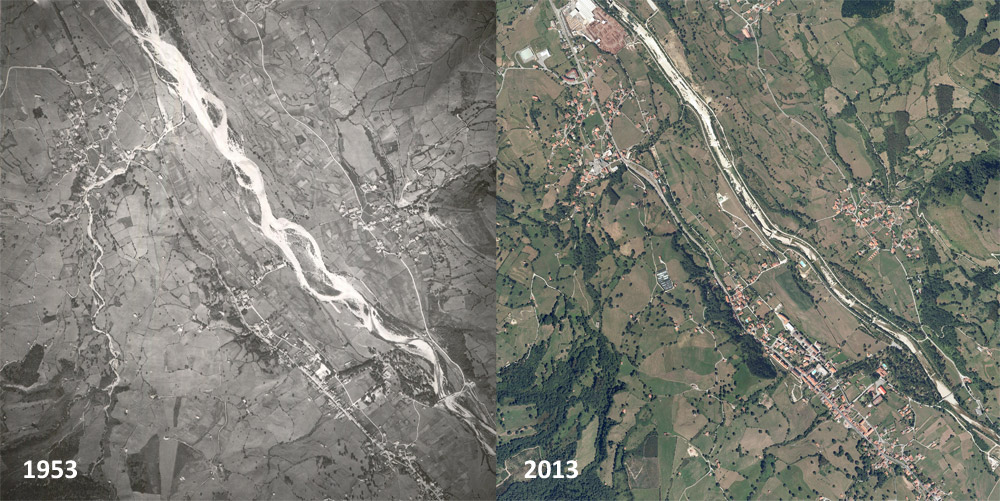
Objectives and project strategies
Our project, Espacio Toranzo -a livestock research centre in Corvera de Toranzo-, is developed on one of these transitional areas where uses are mixed and the agricultural activity is being replaced. We find there all the imperfections of transformed territories: the area is a flood plain occupied by both illegal agricultural buildings and industrial units, crossed by a river canalised years ago, even if its artificial banks are today becoming more and more natural, and where the heritage remains despite their inadequate transformation. This simplification and trivialisation of the landscape is due to the loss of the inner complexity and the built structures -like stone walls or hedges- which organise the area.
Our project, Espacio Toranzo -a livestock research centre in Corvera de Toranzo-, is developed on one of these transitional areas where uses are mixed and the agricultural activity is being replaced. We find there all the imperfections of transformed territories: the area is a flood plain occupied by both illegal agricultural buildings and industrial units, crossed by a river canalised years ago, even if its artificial banks are today becoming more and more natural, and where the heritage remains despite their inadequate transformation. This simplification and trivialisation of the landscape is due to the loss of the inner complexity and the built structures -like stone walls or hedges- which organise the area.
These archetypal landscapes of grass and stone are at risk of disappearing: once finished the livestock activity, wild bushes usually substitute the grass on the hills, as a previous step before the complete regeneration of the deciduous forest of oak and beech trees, which is the potential vegetation of the valley of Toranzo. Although the reforestation could be seen as desirable for an ecological development of the valley, it is a fact that the traditional extensive farming practice can create habitats for a great community of animals: the farming fields, limited by bushes and single trees or groups of them, are also the habitat for invertebrates, small mammals and little birds. All of them feed the predators which live on the slopes of the valley.

The aim of Espacio Toranzo is to keep the productive character of the Pas river: the project is naturally integrated into the landscape by assuming the values and identity of the territory and defined as an attractive scenery for the development of a sustainable economic activity in a natural and human environment. According to this, we propose to develop Espacio Toranzo as a new model of spatial occupation following three guidelines: landscape, education-research and production. Each of them defines a specific goal on which the proposed project is based. In terms of landscape, we propose to build the project from the traces and elements that the traditional extensive farming has left in the valley of Toranzo. The way to transform and shape the territory is also a cultural approach to the territory since both landscape elements and farming techniques are part of the cultural and ethnographic heritage of the valley. More information about the evolution of the local culture can be found at the nearby Ethnographic Museum of San Vicente de Toranzo, where some of the working tools traditionally used in farming and agriculture are shown: it could be interesting to strengthen the ties between this museum and Espacio Toranzo to transmit the rural culture and knowledge.
In relation to the research and educational goals, Espacio Toranzo is designed as an experimental training centre focused on both social and ecological techniques of livestock production. Activities like workshops, lectures, holiday camps, and training courses for shepherds and farmers help to teach the culture of rural areas to children and tourists, while the research centre develops new techniques to improve the sustainability of the farms. Research and education are important objectives to reinforce the social fabric and bring new population interested in keeping the livestock activity in the next years. In relation to this, a further study about the possible evolution of rural towns would be suitable too.
As a productive area, Espacio Toranzo offers to local inhabitants and tourists hand-made crafts and ecological products like cheese, butter or yoghurt. These quality products can be sold at local shops and restaurants or at delicatessen of the nearest cities. Likewise, product tasting and workshops can be performed in Espacio Toranzo to promote these products: it should be recalled that the ultimate aim of the livestock activity is to obtain a profitable consumer good and give a dignified livelihood to the farmers.

Value of the territory
Today, this current landscape presents some strengths and threats. Among the first ones: the Pas river and their banks as the central element of the territory; the agricultural pattern characterised by stone walls and hedges; the archaeological, industrial, cultural and artistic heritage with many prehistoric remains and compact villages of stone houses and palaces; and the cycle and pedestrian green paths which run from north to south between the crop fields. These elements are part of the iconic image of the valley, like a puzzle of trees and bushes, grass, cows, sheds and stone which covers the slopes of the hills.
Today, this current landscape presents some strengths and threats. Among the first ones: the Pas river and their banks as the central element of the territory; the agricultural pattern characterised by stone walls and hedges; the archaeological, industrial, cultural and artistic heritage with many prehistoric remains and compact villages of stone houses and palaces; and the cycle and pedestrian green paths which run from north to south between the crop fields. These elements are part of the iconic image of the valley, like a puzzle of trees and bushes, grass, cows, sheds and stone which covers the slopes of the hills.
On the other hand, the threats: the occupation of the alluvial plain by, among others, new industrial and second home areas non-compatible with periodic floodings; the loss of the agricultural pattern and its defining elements, like the stone walls, the bushes and the lines of trees; the urban sprawl in Alceda, Ontaneda and Soto-Iruz which is transforming their traditional compact urban fabric; the loss of the rural paths due to the abandonment of the agricultural activity; the canalization of the Pas river; and the forestry plantations which substitute the old farming plots and reduce the values of the biodiversity and the landscape.
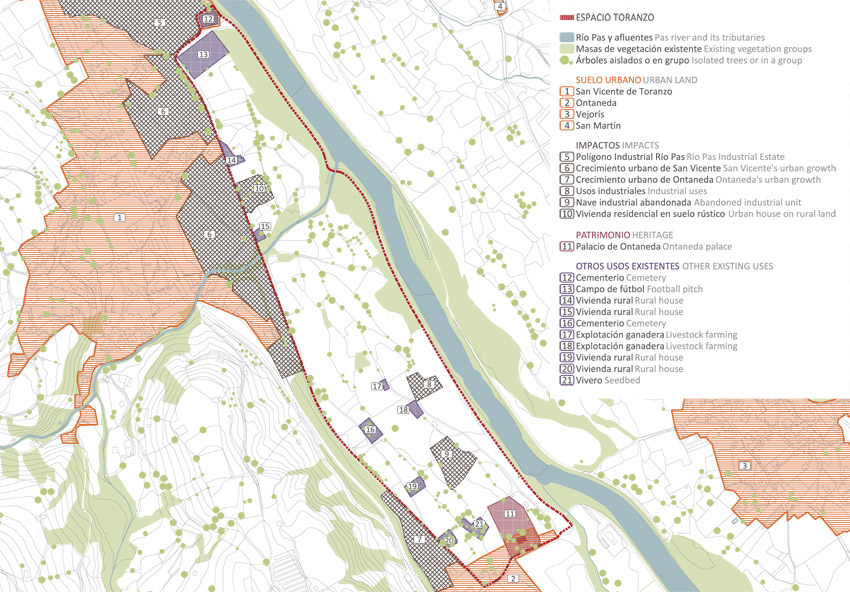
Limits and characterisation of the project site
The project site is a forty-hectares alluvial plain oriented from NO to SE, between the national road N-623 Santander-Burgos and the Pas river, which flows canalised to prevent this area from periodic floodings. The site is relatively plain and dotted by a structure of small sheds, paths and irregular plots which reproduces the structure of stone walls and hedges that we can easily find on the valley. The site is surrounded by some towns: San Vicente, Ontaneda, Alceda and, on the other side of the river, San Martin and Vejorís. In San Vicente, there is an industrial area occupied by a timber company next to the cemetery and the football pitch along the northern limit of the site. Espacio Toranzo is linked to the nearest towns on both sides of the river through the Vía Verde del Pas -literally, the Pas Greenway, the pedestrian and cycle green path built on the tracks left by the missing railway between Ontaneda and Santander- and the Ontaneda-San Vicente cycle path. The Palacio de Ontaneda gardens, placed around an old town palace built in the 18th century which was Queen Isabel II’s holiday residence, are found on the south. There are some remains of a lost industrial activity on the site, like warehouses and other industrial buildings as well as other illegal agricultural constructions.
The project site is a forty-hectares alluvial plain oriented from NO to SE, between the national road N-623 Santander-Burgos and the Pas river, which flows canalised to prevent this area from periodic floodings. The site is relatively plain and dotted by a structure of small sheds, paths and irregular plots which reproduces the structure of stone walls and hedges that we can easily find on the valley. The site is surrounded by some towns: San Vicente, Ontaneda, Alceda and, on the other side of the river, San Martin and Vejorís. In San Vicente, there is an industrial area occupied by a timber company next to the cemetery and the football pitch along the northern limit of the site. Espacio Toranzo is linked to the nearest towns on both sides of the river through the Vía Verde del Pas -literally, the Pas Greenway, the pedestrian and cycle green path built on the tracks left by the missing railway between Ontaneda and Santander- and the Ontaneda-San Vicente cycle path. The Palacio de Ontaneda gardens, placed around an old town palace built in the 18th century which was Queen Isabel II’s holiday residence, are found on the south. There are some remains of a lost industrial activity on the site, like warehouses and other industrial buildings as well as other illegal agricultural constructions.
The views from the valley to the singular elements of the surrounding landscape are used as a strategy which goes beyond the limits of the site to integrate the project into the valley without breaking the physical and visual continuity of paths and river banks. The site is understood as a fragment of the valley and not as an isolated object: since the area is expected to be visited without disturbing the farmers’ work, the design of paths and tracks focus on pedestrians and bicycles only. Motor vehicles are not allowed inside Espacio Toranzo, except for agricultural and security ones. Besides, the project faces the environmental and social impacts described before: it restricts the development of new urban areas between towns to avoid the urban sprawl and improve the perceptual quality of border areas; it defines a new urban facade to be seen from the river and between Ontaneda and San Vicente; it reduces the human pressure on the riverbed and the damages caused by floodings in the area; it stops industrial and housing developments which are not compatible with the dynamics of the river; and it proposes to build a new footbridge which will communicate the site with both sides of the river and Vejorís. In short, the project creates a new public area which will show the feelings and sentiments of the local society.
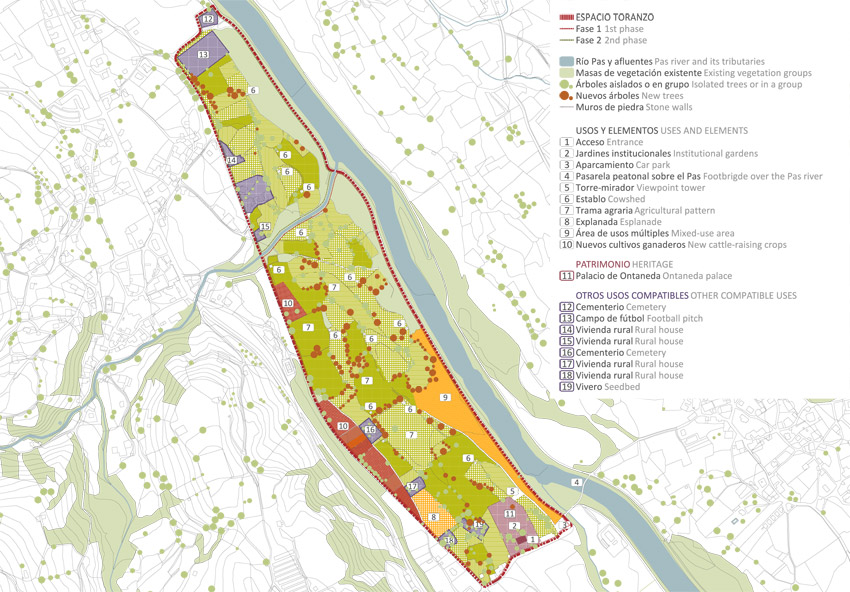
Planning and uses on the project site
The human landscape built in Toranzo has created an iconic image of the valley, which is well-recognised because of their high perceptive and ecological values, showing a sustainable use of the territory and a rich cultural background. The project takes these values to enrich the perception of the existing landscape but not to replace it by a new one.
The human landscape built in Toranzo has created an iconic image of the valley, which is well-recognised because of their high perceptive and ecological values, showing a sustainable use of the territory and a rich cultural background. The project takes these values to enrich the perception of the existing landscape but not to replace it by a new one.
· Buildings: the Palacio de Ontaneda is the head of the research and educational project of Espacio Toranzo. It is placed on the south-easternmost point of the site and is easily accesible from the urban centre of Ontaneda and Vejorís. It houses the classrooms, the lecture room, the computer lab, a café-restaurant prepared for product tasting, a shop for direct selling, labs and a little hall of residence.
A small tower, which in fact is more a metallic structure covered by wooden panels and slats rather than a small building, will be put up on the area near the Palacio de Ontaneda. The tower is an elevated viewpoint from where the pattern of agricultural land plots and their structural elements can easily be understood. Likewise, it is an element which attracts attention to itself as a singular element in the landscape, like the old medieval towers and the belfries which pointed their own position on the territory.
The sheds, the milking parlour and the warehouses use the same architectural language as the tower, made of steel and covered by a wooden external skin. The sheds are planned for sheltering animals but not for milking: due to that, they are elevated upon a low stone wall to protect livestock from humidity, rain and wind. The ceiling is high and composed by wooden panels and slats to provide a natural and constant ventilation of the interior.
· Paths: the external network of pedestrian and cycle paths, which borders and give access to Espacio Toranzo from the nearby towns, is in good condition. However, the inner paths need a complete restoration of their surfaces, which are irregular and show a lack of gravel and compacted soil, before being used by all kind of people regardless their age, health condition or disability. The aim is to open Espacio Toranzo to everyone who wants to learn, experiment and share new ideas about the livestock culture: in some outstanding places, a rest area next to the path will offer new information about the valley, also in Braille. Only security and agricultural vehicles will be allowed to drive on these paths. The other motor vehicles will stay near the Palacio de Ontaneda, in a car park built with a mixed pavement of grass and reinforced concrete. Besides, a new footbridge made of steel and wood will link Vejorís to Espacio Toranzo and help the livestock reach the pastures on the other side of the river.
· Area of education and production: Espacio Toranzo has an educational and productive orientation whose aim is to show the values of the natural and ecological hand-made products and the whole process of chemical-free production to new shepherds, children and tourists. Even if activities like animal care and feeding or grass harvesting are among the most important subjects of this training, the educational project also explains why there are hedges between the plots and how the enclosed fields are used and transformed by the farmers, which is also a practical way to explain how this landscape has been created. Lectures and conferences about landscape, traditional culture, farming and agriculture in Toranzo can be given at the Palacio de Ontaneda in collaboration with local groups of shepherds and neighbours, public administration, universities, schools and other training centres.
· Area of social representation: the project is social-oriented, as a representation of the rural identity of the valley, and aims to be the social heart of the project by reviving traditional uses and activities. Three areas are designed as meeting areas to the south: the Palacio de Ontaneda gardens and two other open areas next to the main paths. Outdoors receptions and tastings can be celebrated in the gardens during the summer and autumn evenings, while the other two open areas are designed to host concerts, outdoors expositions, theatre, picnics or rural sport competitions as well as other activities more related to farming, like livestock fairs or learning about shepherd techniques, animals and tools.
Management
Management of the plots has to deal with a fundamental problem: most of them are private-owned. Instead of acquiring the plots by expropriation, which is an expensive procedure and often protested by the owners, the project tries to involve the owners in a cooperative management of the site, in order to reinforce the productive and social values of the territory. Farmers, as owners, will get involved in the educational activities and the promotion of their identity values. Thereby, many positive effects show up: the most obvious is the money saved, but it is much more important the popular support and involvement which makes the project stronger from an innovative and not only protectionist point of view. Cultural values, character and social identity turn the project into something which is both individual and collective, a desirable public and social space. Somehow, this management system is based on the traditional use of the communal mountain pastures.
Management of the plots has to deal with a fundamental problem: most of them are private-owned. Instead of acquiring the plots by expropriation, which is an expensive procedure and often protested by the owners, the project tries to involve the owners in a cooperative management of the site, in order to reinforce the productive and social values of the territory. Farmers, as owners, will get involved in the educational activities and the promotion of their identity values. Thereby, many positive effects show up: the most obvious is the money saved, but it is much more important the popular support and involvement which makes the project stronger from an innovative and not only protectionist point of view. Cultural values, character and social identity turn the project into something which is both individual and collective, a desirable public and social space. Somehow, this management system is based on the traditional use of the communal mountain pastures.
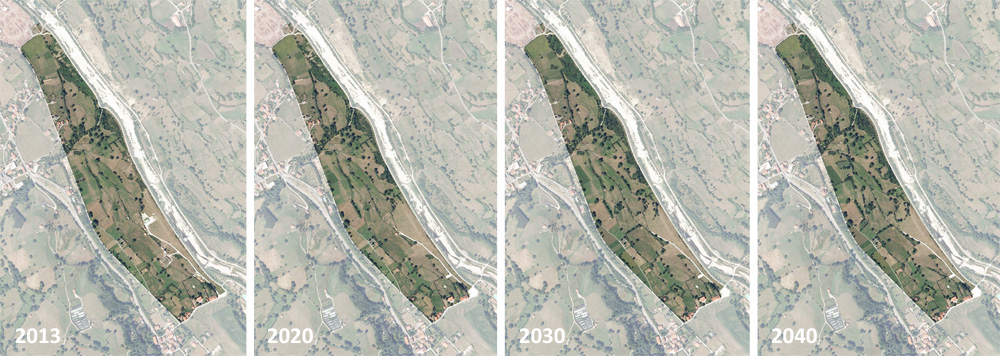
Project evolution
Since the final landscape is the result of livestock, educational and productive activities developed in the area, it cannot be instantly created or kept frozen as a single photo. Therefore, it needs a continuous evolution: not as a theme park but as a process made of calm changes, plot to plot, to reintroduce the values of the landscape without denying the livestock activity.
Since the final landscape is the result of livestock, educational and productive activities developed in the area, it cannot be instantly created or kept frozen as a single photo. Therefore, it needs a continuous evolution: not as a theme park but as a process made of calm changes, plot to plot, to reintroduce the values of the landscape without denying the livestock activity.
The project is expected to be finished by 2040. Then, the new vegetation will have grown enough to show the underlying traces of the territory. In the meantime, vegetation on the river banks will be consolidated to offer a higher ecological background to the Pas river and the Espacio Toranzo.
The new livestock breeders will have been able to keep on their activity with a sustainable and educational focus: the agricultural pattern will have helped to preserve the biodiversity. Meanwhile, the economic activity of the valley will have been boosted by the green tourism attracted to visit Espacio Toranzo, which also will have increased the population. The new agricultural buildings will be then part of the landscape: since they are using a similar architectural language, these new buildings could even be seen as land-art objects. The lines of vegetation and the new crops would be seen in similar terms: all of them define a multi-faceted, sensorial and complex landscape.
After those thirty years, the area will have acquired an important emotional value as an identity place for the inhabitants of Toranzo, and so, it could effectively work to contain the urban sprawl between Ontaneda and San Vicente and preserve the biodiversity. But even if the constructive project is then complete, Espacio Toranzo should continue with the same educational uses and productive dynamics in order to keep the landscape in continuous evolution.
